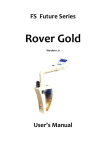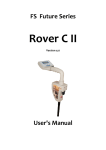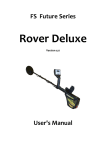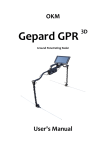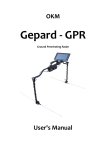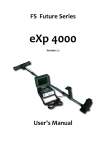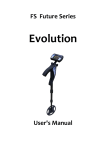Download OKM - User Manual
Transcript
FS Future Series ® Black Hawk User's Manual Any information contained in these operating instructions may be changed without prior notice. OKM does not make any warranty for this document. This also applies without limitation to implied assurances of merchantability and fitness for a specific purpose. OKM does not assume any responsability for errors in this manual or for any incidental or consequential damage or loss associated with the delivery, exploitation or usage of this material. This documentation is available "as presented" and without any kind of warranty. In no circumstances OKM takes responsibility for lost profits, usage or data losts, interruption of business activities or all kind of other indirectly damages, which developed because of errors in this documentation. This instruction manual and all other stored media, which are delivered with this package should only be used for this product. Program copies are allowed only for security and safety purposes. The resale of these programs, in original or changed form, is absolutely forbitten. This manual may not be copied, duplicated or translated into another language, neither in part nor completely, over the copyright matters without the prior written consent of OKM. Copyright ©2002 – 2012 OKM GmbH. All rights reserved. 3 Table of Contents 1 Introduction ........................................................................................................................................... 7 1.1 Preface ........................................................................................................................................... 8 1.2 Important Notes ............................................................................................................................. 9 1.2.1 General Notes ........................................................................................................................ 9 1.2.2 Possible Health Hazards ......................................................................................................... 9 1.2.3 Surrounding Area ................................................................................................................... 9 1.2.4 Voltage ................................................................................................................................... 9 1.2.5 Data Correctness .................................................................................................................. 10 1.3 Maintenance and Services ........................................................................................................... 10 1.4 Danger of Explosion during Excavation ....................................................................................... 10 1.5 Care and Use ................................................................................................................................ 11 1.6 Protecting Your Investment .......................................................................................................... 12 2 Technical Specifications ....................................................................................................................... 13 2.1 Control Unit ................................................................................................................................. 14 2.2 Search Coil ................................................................................................................................... 14 2.3 Power Pack ................................................................................................................................... 14 3 Scope of Delivery ................................................................................................................................. 15 4 Assembly .............................................................................................................................................. 17 4.1 Mounting the Main Unit ............................................................................................................... 19 4.2 Mounting the Search Coil ............................................................................................................ 19 4.3 Assembling the optional 150 cm x 150 cm Search Coil ................................................................ 20 5 Control Elements ................................................................................................................................. 22 5.1 General Controls .......................................................................................................................... 23 5.1.1 On / Off / Volume .................................................................................................................. 24 5.1.2 Display Brightness / LED Light ............................................................................................ 25 5.1.3 Monitor Display .................................................................................................................... 25 5.2 Search Controls ............................................................................................................................ 25 5.2.1 Delay .................................................................................................................................... 26 5.2.2 Interference ......................................................................................................................... 26 5.2.3 Threshold ............................................................................................................................. 26 5.2.4 Sensitivity ............................................................................................................................. 26 5.2.5 Calibration Button ................................................................................................................ 27 6 Field Procedure .................................................................................................................................... 28 6.1 Detection Depth ........................................................................................................................... 29 6.2 Ground Balancing ........................................................................................................................ 29 6.3 Calibration of Discrimination ....................................................................................................... 30 6.4 Operation ..................................................................................................................................... 30 6.5 Pin Pointing .................................................................................................................................. 31 7 Optional Equipment ............................................................................................................................. 33 OKM GmbH www.okmmetaldetectors.com 4 8 Troubleshooting ................................................................................................................................... 35 OKM GmbH www.okmmetaldetectors.com 5 Illustration Index Illustration Illustration Illustration Illustration Illustration Illustration Illustration Illustration Illustration Illustration Illustration Illustration Illustration Illustration Illustration Illustration Illustration Illustration Illustration Illustration Illustration Illustration Illustration Illustration Illustration Illustration 4.1: Telescopic Rod to mount the search coils and main unit ............................................... 4.2: Rod Shaft Lock in the locked position ........................................................................... 4.3: Rod Shaft Lock in the unlocked position ....................................................................... 4.4: Shows the control unit ready to mount to bracket ........................................................ 4.5: Control unit mounted to bracket ................................................................................... 4.6: Telescopic Rod end ........................................................................................................ 4.7: Search Coil mounted to Telescopic Rod ......................................................................... 4.8: Corner ready for assembly ............................................................................................ 4.9: Corner assembled .......................................................................................................... 4.10: create a loop in the cable to insert into straight pieces ............................................... 4.11: Fully assembled coil frame .......................................................................................... 4.12: Connecting the straps .................................................................................................. 4.13: The 150 cm x 150 cm coil can be carried by 1 or 2 people .......................................... 5.1: Complete View ............................................................................................................... 5.2: Bottom of unit showing the mounting clip ..................................................................... 5.3: Rear of unit showing battery and coil connectors ......................................................... 5.4: Right side unit controls ................................................................................................. 5.5: Main Screen .................................................................................................................. 5.6: Left side of the control unit ........................................................................................... 5.7: Delay Screen ................................................................................................................. 5.8: Interference Screen ....................................................................................................... 5.9: Threshold Screen .......................................................................................................... 5.10: Sensitivity Screen ........................................................................................................ 5.11: Front of control unit .................................................................................................... 6.1: Procedure for swinging unit from side to side ............................................................... 6.2: Example of how to properly pin point a target .............................................................. OKM GmbH www.okmmetaldetectors.com 18 18 18 19 19 19 19 20 20 20 20 21 21 23 23 24 24 25 25 26 26 26 26 27 30 31 1 Introduction CHAPTER 1 Introduction 8 1.1 Preface Dear customer, all of the engineers, sales, training and support staff at OKM GmbH would like to thank you for your purchase of the Black Hawk metal detector. The Black Hawk pulse induction detector works on the principle of a time sensitive oscillator which produces an alternating current that passes through a coil producing an alternating magnetic field. This alternating magnetic field creates an eddy current which can detect electrically conductible metal. It uses the induction of a high voltage energy pulse to identify the presence of metals. The Black Hawk is able to locate buried objects within various structures and vessels non-intrusively without having to excavate the area. The facile and flexible handling of the Black Hawk can easily and quickly give reproducible results. With our team of specialists we guarantee that our products are under recurrent control. Our specialists try to implement new developments in terms of further quality improvements for you. By purchasing or using one of our products, we cannot guarantee that during the course of your research that you will be successful and have a find. The recognition of hidden and buried objects depends on a huge number of factors. As you well may know there are different soil types all over the world with different levels of natural attenuation. Variable soil properties can and will hamper and alter ultimate scan measurements. Areas where there is an extreme amount of ground water, varying clays, sands and wet soils making scanning more difficult and may reduce the maximum depth capabilities of any and all detection equipment, regardless of make or model. For more information regarding where this equipment has been used and operated, please visit our website. Our equipment is constantly being tested and when improvements or upgrades are available, we will list them also on our website. It is necessary for our company to protect our developments and all of the information learned during the “Research and Development” phases in creating our technology. We strive to stay within the given framework of legislation, patents and trademark registration. Please take your time to read this User Manual and familiarize yourself with the operation, functionality and how to utilize the Black Hawk. We also offer training for your equipment in our factory and on-site. We strive to maintain worldwide dealer network for assistance and support. Please visit our web site for more information. OKM GmbH www.okmmetaldetectors.com Introduction 9 1.2 Important Notes Prior to using the Black Hawk and its accessories, please read these operating instructions carefully. These instructions give information on how to use the detector and potential sources where precautions should be taken. 1.2.1 General Notes Being an electronic device, the Black Hawk has to be treated with caution and treated with care as with any other electronic device. Any failure to observe the safety precautions given or any use for purposes other than the ones it is designed for may result in damage or destruction of the processing unit and/or its accessories or connected components. The device has a built in anti-tampering module which will destroy the unit if it is improperly opened. There are no end user serviceable parts on the inside of the unit. 1.2.2 Possible Health Hazards If used properly this device normally does not pose any health hazards. According to current scientific knowledge, the high-frequency signals are not harmful to the human body on account of their low power. 1.2.3 Surrounding Area When moving this unit from a cold place to a warmer place, watch out for condensation. Do not operate the unit until possible condensation has evaporated. The unit is not weather or water proof moisture within the electronics can destroy the unit. Avoid strong magnetic fields, which may occur in places where there are large electric motors or unshielded loudspeakers. Try to avoid using this equipment within 50 meters (150 ft) of this type of equipment. Metallic objects on the ground such as cans, tin, nails, screws or debris can influence your scan data and present negative results regarding your scan data. Also it is a good habit to remove any metallic objects off of your person like cellular telephones, keys, jewelry, etc... Do not wear steel toe boots. 1.2.4 Voltage The power supply can not be outside the indicated range of values. Use only approved chargers, batteries and rechargeable batteries which are included within the scope of delivery. Never use the 115/230 Volt mains supply. OKM GmbH www.okmmetaldetectors.com 10 1.2.5 Data Correctness Data errors can occur if: • the power supply of the device or the batteries are too low, • the cables are too long, • the unit is operating to close to devices which sends out disturbances or • atmospheric conditions (electrical storms, lightning, etc...). 1.3 Maintenance and Services In this section you will learn how to maintain your measuring instrument with all included accessories to keep it in good condition a long time and to get good measuring results. The following list indicates what you absolutely should avoid: • penetrating water • strong dirt and dust deposits • hard impacts • strong magnetic fields • high and long lasting heat effect To clean your device please use a clean and dry soft rag or cloth. To avoid any damage you should transport the device and accessories always in the appropriate carrying cases. Prior to using your Black Hawk please be sure that all batteries and accumulators are fully charged. Also do not allow the batteries to completely discharge before recharging them This way your batteries will have a long and durable life. When the unit is not in use, recharge the batteries every 3 months so that they retain their performance. To charge the external batteries use only the approved chargers which are part of our scope of delivery. 1.4 Danger of Explosion during Excavation Unfortunately, the last two world wars also made the ground in many places of the world a potentially explosive scrap heap. A host of those lethal relics are still buried in the ground. Do not start digging and hacking for an object wildly when you receive a signal of a piece of metal from your device. Firstly, you might indeed cause irreparable damage to a truly rare find, and secondly, there is a chance that the object reacts in an insulted way and strikes back. Note the color of the ground close to the surface. A red or reddish color of the ground is an indicator of rust traces. As regards to the finds themselves, you should definitely pay attention to their shape. Curved or round objects should be a sign of alarm, especially if buttons, rings or little pegs can be OKM GmbH www.okmmetaldetectors.com Introduction 11 identified or felt. The same applies to recognizable ammunition or bullets and shells. Leave that stuff where it is, do not touch anything and, most importantly, do not take any of it home with you. The killing machines of war made use of diabolical inventions such as rocker fuses, acid fuses and ball fuses. Those components have been rusting away in the course of time, and the slightest movement may cause parts of them to break and be triggered. Even seemingly harmless objects such as cartridges or large ammunition are anything but that. Explosives may have become crystalline over time, that is, sugar-like crystals have formed. Moving such an object may cause those crystals to produce friction, leading to an explosion. If you come across such relics, mark the place and do not fail to report the find to the police. Such objects always pose a danger to the life of hikers, walkers, farmers, children and animals. 1.5 Care and Use The Black Hawk is a sturdy instrument, but it is not designed to withstand abuse. In caring for your Black Hawk, there are several important "DOs" and "DO NOTs" to remember. • DO NOT use it to beat bushes out-of-the-way, flatten area by swinging wildly or pry rocks loose. • DO NOT drop the machine into water or use it while it is raining or wet. • DO NOT leave it exposed at night where dew could form on it. • DO NOT store it in places that could get extremely hot. • DO NOT leave it in the trunk or boot of a car where high temperatures could build up. • DO NOT spray lubricants, or any type of cleaners, solvents, sealants or other chemicals into or onto the electronic parts, switches or controls. • DO NOT attempt to modify or repair the detector’s electronics as this will void your detector's warranty. • DO clean your unit with a soft dry or slightly damp cloth to remove dust and residue from the previous use. • DO use the device within the proper operating guidelines. • DO use the detector with the proper power pack as to not cause damage to the unit. The warranty does not cover damage resulting from an accident, neglect or abuse. OKM GmbH www.okmmetaldetectors.com 12 1.6 Protecting Your Investment Often detector users become disappointed when their new detector slowly becomes less and less responsive and seems to have lost some of its original peak performance. You can help prevent this from happening to your detector by following these basic care and protection guidelines. • Operate your detector exactly as recommended in this Operator Instruction Manual. • Use only the OKM Power Pack or other approved power supplies. • The search coil cable is hard-wired to the search coil and protected by a stress relief. Inspect the stress relief frequently to make sure it is firmly attached and intact. • Keep cables properly wound around the extension pole and protect them during use. Floppy, pinched, or damaged cables may short, causing unnecessary replacement of the search coil. • Sweep the search coil carefully, especially when using around rocks and building foundations. Avoid hitting the search coil against hard, solid objects and surfaces. • Keep your search coil slightly off of the ground during the sweep, especially when using in gravel or hard, rocky dirt. • The search coil is waterproof and can be submerged in either fresh or salt water. After the search coil is used in salt water, rinse it and the lower stem assembly well with fresh water to prevent corrosion of the metal parts. • The search coil is waterproof but the electronics are not, so always prevent any moisture or water from entering the control housing and never allow the cable connectors to become submerged in water. • If working in or near water, or if there is a possibility of rain, use a protective weather resistant pouch or plastic bag to cover the control housing. Make sure it can “breathe” in order to ensure against condensation buildup inside. • After each use, clean the detector with a soft cloth to remove dust, moisture, or other contaminants. • When transporting the detector in a car during hot weather, store it on the floor of the passenger compartment if possible. Using a carry bag gives additional protection. In any case, never allow the detector to roll around unprotected in the trunk or back of a pickup truck. • Protect your detector from dust, moisture, and extreme temperatures during storage. • When shipping, use the original factory carton or similar heavy-duty container and provide sufficient padding around all parts. • Treat your detector as you would any sensitive electronic instrument. Though it is designed to withstand the demands of normal treasure hunting, proper care is essential. OKM GmbH www.okmmetaldetectors.com 2 Technical Specifications CHAPTER 2 Technical Specifications 14 The following technical specifications are medial values. During operation slight variations are possible. 2.1 Control Unit Dimensions (H x W x D) ................................................................................................ 80 x 160 x 210 mm Weight ........................................................................................................................................ about 1 kg Voltage ............................................................................................................. 12 VDC ±5%, 6 W maximal Safety Class ......................................................................................................................................... IP40 Operating Time (fully charged Power Pack, 25° C) ................................................. approximately 6 hours Display ............................................................... 110 mm Diagonal, 400 MCD, 480 x 272 Pixel TFT, Color Processor............................................................................................... OMAP 3530@600MHz, Power VR Feedback............................................................................................................................. acoustic, visual Operating Temperature ...................................................................................................... -5° C to +40° C Storage temperature ........................................................................................................ -20° C to +60° C Air humidity ............................................................................................................................. 5 % to 75 % Waterproof ............................................................................................................................................. No 2.2 Search Coil Sensor technology ..................................................................................................................... SCMI-15-D Mono Coil ............................................................................... 110 Hz ±15% High Voltage Pulse Induction 2.3 Power Pack Lithium Polymer Accumulator ............................................................................. Output Voltage 12,7 VDC Output Current................................................................................................................................ max 3 A Capacity ...................................................................................................................................... 4400 mAh Weight ................................................................................................................................................ 605 g Charger................................................................... Output Voltage 19 VDC / Input 100-240 VAC 50-60 Hz OKM GmbH www.okmmetaldetectors.com 3 Scope of Delivery CHAPTER 3 Scope of Delivery 16 In the following section you can find all the standard equipment and shipping. The scope of delivery can be different in some circumstances because of some optional accessories which should not be included in the basic equipment. Basic Professional Control Unit 1 1 Carrying Strap 1 1 Wireless Headphones 1 1 Telescopic Rod Assembly 1 1 OKM Power Pack & Charger 1 1 International Travel Adapter 1 1 User's Manual 1 1 Shipping Carton 1 2 36 cm Search Coil 1 1 16 cm Search Coil optional 1 150 cm x 150 cm Search Coil optional 1 12 V Car Charger optional optional Table 1: Scope of delivery In the event that there is an item that is missing within the scope of delivery (a “Packing List” or “Lieferumfang”) upon receipt of your Black Hawk, contact the dealer immediately. OKM GmbH www.okmmetaldetectors.com 4 Assembly CHAPTER 4 Assembly This section explains how to assemble and prepare the Black Hawk unit for operation. 18 The main unit mounts directly to the mounting bracket on the hand grip and the search coil mounts to the coil connector of the Telescopic Rod Assembly. Mounting bracket on the hand grip Forearm Brace Search Coil Connector Hand Grip Illustration 4.1: Telescopic Rod to mount the search coils and main unit Adjusting the telescopic rod is very important. To avoid straining any muscles and to allow for more comfort while working with the unit, a properly adjusted telescopic rod is essential. Illustration 4.3: Rod Shaft Lock in the unlocked position Illustration 4.2: Rod Shaft Lock in the locked position To adjust the telescopic rod length or the hand grip the tab locks needs to be opened as in illustration 4.3. Once opened the shaft you can extend or contract the rod to your desired length. Once the desired length is reached, simply lock the lever down as shown in illustration 4.2. Be sure that the hand grip is also properly adjusted for comfort. OKM GmbH www.okmmetaldetectors.com Assembly 19 4.1 Mounting the Main Unit When the main unit is mounted to the telescopic rod it looks like that in illustration 4.5. Coil Connector Illustration 4.4: Shows the control unit ready to mount to bracket Illustration 4.5: Control unit mounted to bracket 4.2 Mounting the Search Coil Assembling the search coils to the telescopic rod is very simple. Unscrew the nylon bolt, be sure the rubber washers are seated next to the shaft. Insert the end of the shaft onto the coil, insert the bolt and tighten. Finger tight only so that the coil does not move. Make note that on the end of the telescopic rod there is a nylon bolt with 2 rubber washers, these are important to keep the coil firmly in place. Illustration 4.6: Telescopic Rod end Illustration 4.7: Search Coil mounted to Telescopic Rod OKM GmbH www.okmmetaldetectors.com 20 4.3 Assembling the optional 150 cm x 150 cm Search Coil To assemble the 150 cm x 150 cm (5' x 5') search coil first unpack all of the components and lay them on the ground with the wire up and the clips up. First assemble the corners of the search coil before assembling it completely. In illustration 4.8 you will simply insert the connectors together to complete the assembly as shown in illustration 4.9. Be sure to feed the extra wire through the corners so they allow for the construction of the frame. Illustration 4.8: Corner ready for assembly Illustration 4.9: Corner assembled When assembling the 150 cm x 150 cm search coil pull the extra cable and take out the slack, the extra cable is there so that the unit can be folded together. After all of the corners are assembled create a loop or twist in the cable and insert the extra cable into the straight pieces (see illustration 4.10). Complete the assembly of the straight pieces (see illustration 4.11). Illustration 4.10: create a loop in the cable to insert into straight pieces Illustration 4.11: Fully assembled coil frame OKM GmbH www.okmmetaldetectors.com Assembly 21 The straps to the 150 cm x 150 cm search coil must be mounted in order to carry the unit. It can be comfortably carried by 1 or 2 people. Illustration 4.12: Connecting the straps The straps can be carried by 2 people where each person has a strap or by 1 person by criss-crossing the straps and carry the coil over the shoulder. Illustration 4.13: The 150 cm x 150 cm coil can be carried by 1 or 2 people OKM GmbH www.okmmetaldetectors.com 22 5 Control Elements CHAPTER 5 Control Elements In this section we explain more about the fundamental use of all control elements for the Black Hawk measuring instrument. All connections, inputs and outputs are explained in detail. OKM GmbH www.okmmetaldetectors.com Control Elements 23 First we will explain the various ports and connectors. Understanding the various functions makes it much easier to prepare the unit for operation. Telescopic Rod Assembly Main Unit with Display and Controls Search Coil Illustration 5.1: Complete View In illustration 5.2 you can clearly see the mounting clip which is used to mount the unit to the Extension shaft. When mounting the control unit to the telescopic rod, be sure that it locks into place, usually indicated by hearing a click. Mounting Bracket Calibration Button External Speaker Illustration 5.2: Bottom of unit showing the mounting clip The external speaker shown in illustration 5.2 is controlled by the ON/OFF and Volume control knob. It should be inspected after each use to ensure that there is no debris, sand, water or any other contaminants that may have entered the unit during operation. 5.1 General Controls There are seven controls on the Black Hawk unit. On the right side of the unit there is the ON/OFF and Volume, Brightness and LED light. On the left side of the unit is the Delay, Interference, Threshold and Sensitivity control. On the front of the unit is the Calibration Button. OKM GmbH www.okmmetaldetectors.com 24 In illustration 5.3 you see the LED that can illuminate your path in the dark, the battery connector and the search coil connector. LED for night searches Search Coil Connector Battery Connector Illustration 5.3: Rear of unit showing battery and coil connectors The battery and search coil connectors are color coded to make for a quick and easy assembly of the unit. Display Brightness Monitor Display Calibration Button ON/OFF and Volume Illustration 5.4: Right side unit controls 5.1.1 On / Off / Volume The illustration 5.4 shows the ON/OFF/Volume knob. This control will turn the unit on and off as well as control the volume of the internal speaker. The unit requires between 8 and 10 seconds to start. The wireless headphones can be used. When the unit is turned on and you wish to use the headphones, be sure to keep the volume low. You can still adjust the volume of the headphones separately. OKM GmbH www.okmmetaldetectors.com Control Elements 25 5.1.2 Display Brightness / LED Light The illustration 5.4 shows the Display Brightness knob. Use this control to either dim or brighten the monitor. For working with the unit during the day most will adjust the monitor and make it very bright. During the evening, the monitor can be dimmed. When the unit is dimmed to the low setting, the LED light will illuminate to assist you for night searches. When it is to the lowest setting then all illumination will be turned off (no LED light and no monitor display). 5.1.3 Monitor Display After turning on the detector the Monitor Display will show the main screen accordingly to illustration 5.5. The main screen shows the signal curve as well as all of the sub-screens for the search controls. In a single instance one can see the other settings instantly. When one of the other controls are moved, the screen will automatically change to the setting that is being changed. Illustration 5.5: Main Screen 5.2 Search Controls In illustration 5.6, the controls on the left side of the unit are shown. These are your primary controls to ground balancing the unit. Half of the ground balancing process has been automated simplifying the task of ground balancing the unit. Sensitivity Interference Calibration Button Threshold Delay Illustration 5.6: Left side of the control unit By using these controls you will adjust the search coils to specific soil conditions. OKM GmbH www.okmmetaldetectors.com 26 5.2.1 Delay The Delay knob as shown in illustration 5.6, controls the speed and timing in which the pulses are received. In conjunction with the Interference the timing can be properly set. When this function is used properly there will be a ticking sound. It should tick approximately 3 - 5 ticks per second. Illustration 5.7: Delay Screen 5.2.2 Interference The Interference knob as shown in illustration 5.6, controls the course tuning element that assists with the Delay. Initially after the unit is turned on, the Interference button will be adjusted so that the sound is just muted. Afterward the Delay function is used for finer tuning. Illustration 5.8: Interference Screen 5.2.3 Threshold The Threshold knob as shown in illustration 5.6, controls the object size filter. Turn it to "0" to get response from all objects of any size. While setting it to a higher value the detector only responds to larger metal objects and skips the smaller ones. Illustration 5.9: Threshold Screen 5.2.4 Sensitivity The Sensitivity knob as shown in illustration 5.6, is used to either increase or decrease the sensitivity of the receiving search coil. The size of the coil will determine where the Sensitivity needs to be set. For example, when using the larger search coil the Sensitivity is usually increased to look for larger objects that are deeper in the ground. Illustration 5.10: Sensitivity Screen OKM GmbH www.okmmetaldetectors.com Control Elements 27 5.2.5 Calibration Button This function will perform the automatic ground balance of the built in magnetometer enabling the unit to discriminate between ferrous and non-ferrous metals. Calibration Button Illustration 5.11: Front of control unit For the person who is only looking for non-ferrous metals, discrimination is very important. When the unit is not calibrated the detection of non-ferrous metals still takes place. The only difference is that ferrous metals will not have the “FE” sign show up in the main display screen. After calibrating the Black Hawk the function of discrimination is automatic. Please make note that some soil conditions may make it difficult to discriminate some metals. OKM GmbH www.okmmetaldetectors.com 28 6 Field Procedure CHAPTER 6 Field Procedure This chapter gives practical instructions about the general procedure of scanning an area. The different scanning methods and procedures will be explained in detail. In this section you will learn more about the different operating modes of the Black Hawk. Every function is explained in the following subsections. OKM GmbH www.okmmetaldetectors.com Field Procedure 29 The Black Hawk metal detector is actually a dual detector. Besides the pulse induction metal detector, there is also a built in magnetometer which enables the unit to discriminate between ferrous and nonferrous metals. When a ferrous metal is detected there is a notification which will appear on the display notifying you that the metal detected is ferrous. It will show up on the top left portion of the screen as "FE". The Black Hawk is fully automatic in terms of knowing which detector coil is attached. So whether it is the small coil or the large coil the unit knows where to set many of the automated processes. The process of detection is done by using an eddy current. An eddy current uses an electromagnetic induction to create a reaction within metals. This reaction within the metals creates electrical conductivity or an anomaly which actually disturbs the flow of the current. When this disturbance is realized, the detector then reports the anomaly. The surface of the material being detected must be accessible to the current. Various finishes and coverings may cause bad or weak readings. An alternating current in the coil generates a changing magnetic field. The larger the coil, the larger the field is. With a large field only larger items can be found. When using a smaller coil the field is also smaller enabling the detection of smaller items. All of this is done by reporting the variations within the magnetic field which is created by the coils. After an item is detected, allow for a recovery time or enough time for the creation of another magnetic field. 6.1 Detection Depth In theory, the larger the item is and the longer it has been in the ground, the deeper it can be detected. With a pulse induction detector, there is a high voltage surge sent into the ground creating a large magnetic field. Items with an electrical conductance will distort the magnetic field causing the detector to react. The Delay function initializes the recurrence of the pulse. This in combination with the size of the coil will affect the ultimate possible depth. Varying soils and layers within the soil will also affect the ultimate depth of the detector. Using a pulse induction metal detector enables you to search in soils with a higher magnetic permeability (highly mineralized) or susceptibility than other soils. Although in such highly mineralized soils, determining if an object is ferrous or non-ferrous becomes exponentially more difficult depending on the amount of mineralization. Air tests typically will be able to detect a metallic object twice the distance as the size of the coil. 6.2 Ground Balancing The ground balance of the Black Hawk detector is mandatory for the proper operation of the unit. Half of the balancing is done automatically, the other half by making a few simple adjustments: 1. Connect a fully charged battery to the Black Hawk unit. 2. Hold the unit 5 to 10 cm above the ground. 3. Turn on the unit and after 8 to 10 seconds the display will turn on. 4. Set the volume to the desired level or set to low and turn on the wireless headphones. OKM GmbH www.okmmetaldetectors.com 30 5. Set the values to “50” for the Delay and Interference. 6. Set the value to “0” for the Threshold and Sensitivity. 7. Slowly turn the Interference knob until the high frequency pitch becomes quiet. It should be set directly at the point where it is muted. 8. Very slowly turn the Delay knob in the other direction until a “Ticking” sound is heard. 9. The desired tick rate is about 3 - 5 ticks per second. To fine tune the tick rate, use the Threshold knob. 6.3 Calibration of Discrimination After the unit has been ground balanced, the unit must be calibrated to discriminate between ferrous and non-ferrous metals. This is a very simple procedure: 1. Find a clear area that does not have metallic objects. 2. Push the "Calibration" button. 3. During the calibration process the monitor shows "Calibration". 4. Swing the unit level to the ground left and right until the monitor returns to normal. 5. Go over a piece of ferrous metal to see the "FE" indication on the screen. 6.4 Operation The unit needs to swing slowly over the ground or area to be scanned. It is important not to change the height of the coil during the scanning procedure. If the unit is too close to the ground it is possible that the coil will receive feedback from the ground itself. If this happens, simply swing the coil a little higher above the ground. In illustration 6.1 is a description showing the approximate time required to sweep from one side to the next side. Illustration 6.1: Procedure for swinging unit from side to side OKM GmbH www.okmmetaldetectors.com Field Procedure 31 Practice a smooth sweep of the search coil from side-to-side keeping the coil close to the ground throughout the swing. Each pass of the coil should take approximately 3 seconds from right to left, 3 seconds to return from left to right. Walk forward slowly. Take small steps no greater than half of a normal stride. Make sure each pass of the coil overlaps the last by at least half the length of the loop. Do not lift the coil at the end of each swing. Keep it close to the ground and at the same height at all times. To become comfortable sweeping the loop does take some practice. Relax, loosen up and find a comfortable grip on the handle. Premature fatigue may result from gripping the handle too tightly, an improperly adjusted rod or elbow support, and limited body movement. Hold the handle loosely. Adjust the rod and elbow support for comfort and keep the elbow strap loose. Use your arm, shoulder and even your back a little to allow for a smooth even sweep of the coil. 6.5 Pin Pointing Once an object has been found, move the coil off to one side of the target area and slowly swing the coil over the area until it beeps directly over the target. Make notes of the area where it begins to give an audio signal and where the signal begins to fade. Where the signal becomes stronger that is the point of where the edge of the anomaly is and where the signal begins to fade is the other side. Illustration 6.2: Example of how to properly pin point a target In illustration 6.2 we are showing the different positions that are necessary to properly pin point an anomaly. From "Position 1" sweep the detector over the anomaly, then go to "Position 2", repeat the process and then at "Position 3" again. When this is done from three different sides then you will know exactly how long and wide the anomaly is. OKM GmbH www.okmmetaldetectors.com 7 Optional Equipment CHAPTER 7 Optional Equipment 34 Here you can find additional information on accessories that can compliment the basic kit. Keep in mind that the mentioned accessories are not included in the normal scope of delivery. 16 cm Search Coil 150 cm x 150 cm Search Coil OKM Power Pack with charger and travel adapter Auto Charger for OKM Power Pack Please contact OKM or an authorized dealer for more information, accessories or support. OKM GmbH www.okmmetaldetectors.com Troubleshooting 35 8 Troubleshooting CHAPTER 8 Troubleshooting In this chapter we will discuss frequently asked questions. OKM GmbH www.okmmetaldetectors.com 36 The most common problem is that the battery is low or in need of a charge. In every case, please ensure that the battery is fully charged. Questions Answers Why do I have to constantly change the delay? • • • Why is it so hard to balance the unit? • • • Changing the delay usually occurs after a strong signal is received or you accidentally change the setting. There could be an area with higher mineralization causing the delay to be reset. When the unit was balanced to the ground, it was either too low or too high above the ground. The coil is directly on the ground as you are setting the delay and threshold. You may be too close to an electrical appliance or motor. Be sure your area where you are balancing the unit is clean. Why does it beep and there is no target? • Your coil is too close to the ground and it is receiving feedback. There is a target, then it goes away, why? • Check your ground balance, most likely you adjusted it in the field and have reset the unit and balanced it out. The size of the item may be extremely small or it may lie just within the range of the detector. • I hear a target, then I can't find it again, why? • The coil may be touching or just about to touch the ground and give a signal that there is an anomaly. I don't see anything in the display • Adjust the brightness of the monitor. If in direct sunlight put hand over display to shade it. I don't hear any tones • Check to make sure that the volume is loud enough and that there is a coil attached. If there is no coil then the unit will remain silent. Check the coil to ensure that there are no tears in cable. You need to ground balance the unit again, perhaps an adjustment knob was accidentally turned. • • OKM GmbH www.okmmetaldetectors.com



































